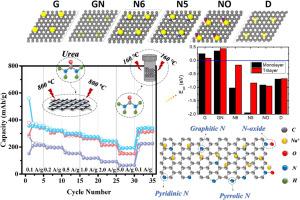采用高压氮掺杂方法制备闭孔结构氮掺杂硬碳钠离子电池阳极
IF 5.6
3区 材料科学
Q1 ELECTROCHEMISTRY
引用次数: 0
摘要
钠离子电池(sib)的硬碳(HC)阳极的插层机制取得了良好的电化学性能,但低电位下Na+的缓慢扩散动力学对高功率应用构成了重大障碍。本研究研究了氮(N)掺杂对sib应用中HC电化学性能的影响。x射线光电子能谱(XPS)分析表明,高温烧结过程(HT-NHC)和高压水热过程(HP-NHC)的N含量对HC结构中N的掺入有影响。HP-NHC中吡啶N的含量为9.9 mol %,高于HT-NHC的6.0 mol %。经过200次循环,HP-NHC在0.5 a /g下提供了331 mAh/g的高可逆容量。HP-NHC电化学性能的提高是由于n掺杂的倍增效应,提高了Na+的转移速率。理论计算结果表明,在HC材料(HCMs)表面,Na+与石墨和石墨氮官能团之间存在弱静电相互作用。此外,缺陷、吡咯N、N氧化物和吡啶N有利于Na+的吸附。吡咯烷和其他含N官能团为Na+提供了足够的吸附位点,从而提高了HT-NHC和HP-NHC的容量,支持了我们的研究结果。本文章由计算机程序翻译,如有差异,请以英文原文为准。

N-doped hard carbon with closed-pore structure via a high-pressure nitrogen doping approach as anodes for Sodium-ion batteries
The slow diffusion kinetics of Na+ at low potential constitute a significant hurdle to high-power applications, even though the intercalation mechanism of hard carbon (HC) anodes for sodium-ion batteries (SIBs) achieves respectable electrochemical performances. This study investigates nitrogen (N) doping effects on the electrochemical performance of HC for SIBs’ applications. X-ray photoelectron spectroscopy (XPS) analysis indicates that the N content of the high-temperature sintering process (HT-NHC) and high-pressure hydrothermal process (HP-NHC) impacts the N incorporation into the HC structure. The content of pyridinic N in HP-NHC is 9.9 mol %, which is higher than that in HT-NHC of 6.0 mol %. After 200 cycles, HP-NHC delivered a high reversible capacity of 331 mAh/g at 0.5 A/g. The improved electrochemical performance of HP-NHC is attributed to the multiplier effects of N-doping, which improves the Na+transfer rate. The results of theoretical calculations indicate a weak electrostatic interaction between Na+ and graphite and graphitic nitrogen functional groups on the surfaces in HC materials (HCMs). Moreover, the defects, pyrrolic N, N-oxides, and pyridinic N benefit Na+ adsorption. Pyrrolic N and other N-containing functional groups offer adequate adsorption sites for Na+ and hence boost the capacity of HT-NHC and HP-NHC, supporting the results of our investigation.
求助全文
通过发布文献求助,成功后即可免费获取论文全文。
去求助
来源期刊

Electrochimica Acta
工程技术-电化学
CiteScore
11.30
自引率
6.10%
发文量
1634
审稿时长
41 days
期刊介绍:
Electrochimica Acta is an international journal. It is intended for the publication of both original work and reviews in the field of electrochemistry. Electrochemistry should be interpreted to mean any of the research fields covered by the Divisions of the International Society of Electrochemistry listed below, as well as emerging scientific domains covered by ISE New Topics Committee.
 求助内容:
求助内容: 应助结果提醒方式:
应助结果提醒方式:


